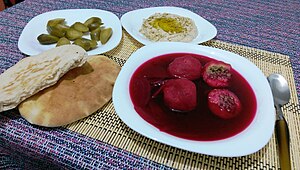Kubbeh
 A bowl of kubbeh adom, or red kubbeh in a beet broth. | |
| Alternative names | Kubbe, kubeh, chamo kubbeh, chamo kubbe, adom kubbeh, hamusta kubbeh |
|---|---|
| Type | Soup/dumpling |
| Course | Main dish |
| Place of origin | Iraq |
| Region or state | Baghdad |
| Serving temperature | Hot |
| Main ingredients | Coarse semolina, water, olive oil, salt, ground beef, vegetables |
| Variations | Kubbeh Khamo (yellow kubbeh), Kubbeh Khamusta (sour kubbeh), Kubbeh Adouma (red/beet kubbeh), Kubbeh Bamia (with okra and tomato paste), Kubbeh Za'atar (with Hyssop and Lemon juice). |
Kubbeh, also known as kubbe, is a family of dishes Iraqi and Kurdish Jewish origin that are popular in Israel, and are traditionally served for Shabbat and other holidays; and consist of a filled dumpling soup, with a wide array of fillings and soup broths. Once almost exclusively made at home by members of the Iraqi and Kurdish Jewish community, since the early 20th century the popularity of the dish has expanded to Israelis of all backgrounds and is commonly served in restaurants across the nation, most notably in the Machane Yehuda market in Jerusalem[1][2][3][4][5][6].
A different Kubbeh served in the Levant of Lebanon, Israel, Palestine, Jordan and Syria consists of the same concept but using burghol[check spelling] (bulger) instead of semolina and no soup base. It is a paste of meat and bulger that is filled with fried meat, onion and pine nuts. It is also called Kubbeh, and if served in a soup it is usually called Kubbeh bil laban, meaning kubbeh in salty yogurt.[citation needed]
References
- ^ Lyons Bar-David, Molly (1964). The Israeli Cookbook: What’s Cooking in Israel’s Melting Pot.
- ^ Nathan, Joan. King Solomon's Table.
- ^ Solomonov, Michael. Israeli Soul. HMH.
- ^ Marks, Rabbi Gil. The Encyclopedia of Jewish Food.
- ^ Solomonov, Mike. Zahav. HMH.
- ^ "Marak kubbeh adom". Food52. Retrieved 7 January 2020.
